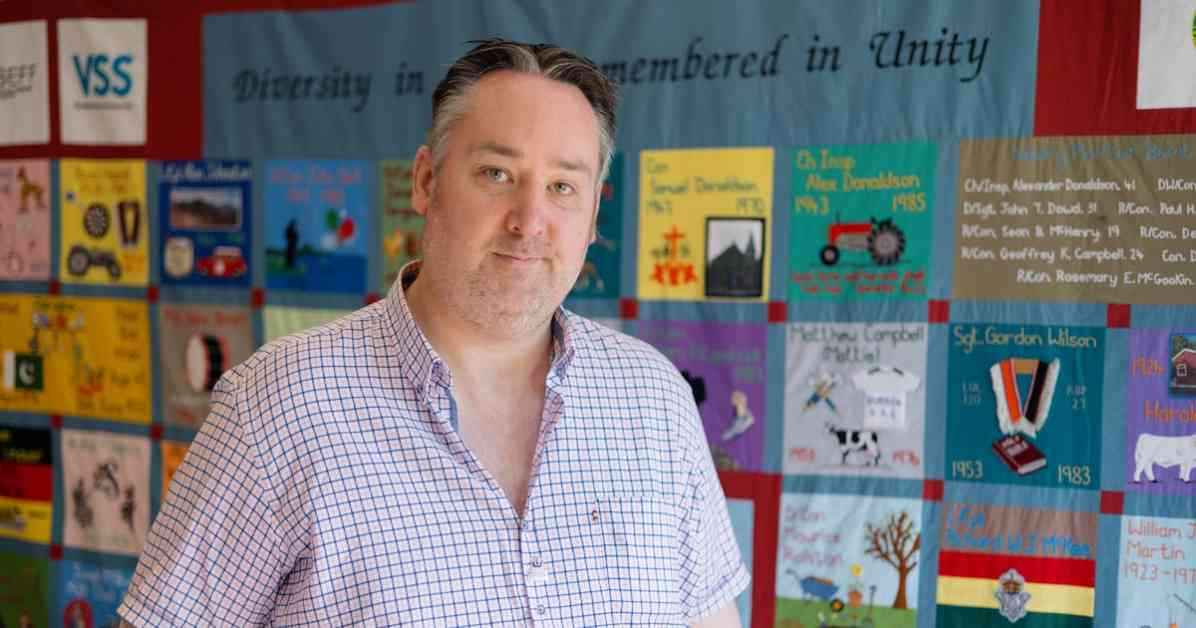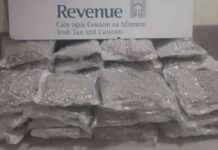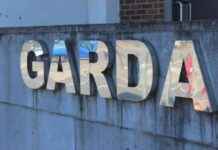A graveyard memorial was put up to honor a Co Donegal-born RUC officer that got totally wrecked within a few weeks, and now it’s the main attraction of an exhibition remembering the Troubles. The big scratches left by the angle grinder that was used to mess up John Doherty’s marble headstone took a while to make, but the folks who swiped it from his grave at Castlefin St Mary’s Church in Co Donegal in 2023 had plenty of time on their hands. The messed-up headstone, along with a memorial quilt that pays tribute to some of the folks who died during the Troubles, were part of an exhibition at the Church of Ireland‘s Synod in Naas, Co Kildare, which wrapped up on Saturday.
The headstone was set up on October 28th, 2023 to mark the 50th anniversary of when the IRA took the life of Mr Doherty, a Catholic Royal Ulster Constabulary officer, while he was visiting his mother at their house near Lifford. Shortly after it was put up, it was swiped under the cover of night. A month later, also under the cover of darkness, it showed up again with the inscription all messed up, with the harp and shamrock symbol of the RUC cut up. On the back, some words were carefully chiseled: “Remember All The Victims of RUC Collusive Behaviour and loyalist Paramilitaries. RUC/PSNI Sectarian Police – Enforcing British Rule in Ireland. Not Welcome”. The last sentence of the text on the back of the stone, which had been revealed just a few weeks before in front of top Garda and PSNI officers, had been colored in with the Irish Tricolour, with “Up The ‘Ra” written in green, white, and orange.
“There’s something pretty cruel about that, right? It’s dark. Death is supposed to be sacred in Ireland,” said the exhibition’s organizer, Kenny Donaldson, who is the director of the South East Fermanagh Foundation (SEFF). Mr. Doherty had joined the Metropolitan Police in London a few years before all the Troubles started, but he switched to the RUC in late 1969 to be closer to his five brothers, six sisters, and parents at their Ardnasool home. His brother Terry, who served in the Irish Army for over 25 years, mentioned, “No one knew things were gonna get so bad when he decided to come back.” He talked about how their home was watched for almost a year and a half before his brother was killed, and his girlfriend was hurt, as he was turning his car on the narrow lane on a Sunday evening. His mother hurried out to see what was going on.
A man who had no reason to be in Ardnasool had driven down that quiet road so many times before the incident that he got a nickname – the name of a country music singer – from Mr. Doherty’s siblings. “John was a target for the IRA, but he loved coming home to see our mother. We were always scared for him, but you always hope that nothing bad will happen,” Terry said. Because of his Catholic background, he was marked for death: “By killing him, the IRA scared a lot of other Catholics away from joining the RUC, or made those who were already in it want to leave,” Terry added. Nobody has been held accountable for the destruction. “The guards did what they could, but there were no cameras, and these cowardly folks did their dirty work in the dark, like they always do,” Terry mentioned. The headstone and the quilt were put on display by the SEFF, which helps folks on both sides of the Border who are going through tough times because of traumatic experiences caused by terrorism.
The quilt, the eighth one finished so far, remembers, among others, the Quinn children who were killed by a loyalist paramilitary firebomb in 1998, along with Ross and Ann Hearst, a father and daughter who served in the RUC and were killed by the IRA three years apart. The quilts are taken by SEFF to schools and groups to share the stories of those who were lost and those who were left behind, including places where people “might have thought we’d have a hard time, but that wasn’t the case,” said Mr. Donaldson. Last year, the organization went to Latton GAA club in Co Monaghan, the home club of the late Fine Gael senator Billy Fox, who was murdered by the IRA in March 1974 when some of its members raided his girlfriend’s house in Tircooney.
One of the earliest exhibitions happened at St Mary’s College in west Belfast ten years ago, where some visitors had a tough time seeing emblems of Orange Lodges, GAA clubs, the RUC, and the Irish Army on one quilt. Mr. Donaldson remembered one young woman’s initial negative reaction. “I said nothing and let her keep looking. Then, she figured it out. She said to me, ‘It’s because they’re all innocent, right?’.” The quilts never intentionally remember anyone involved with the IRA, other republican groups, or loyalist paramilitaries. “And they won’t. Those folks signed up for a code that let them go out and kill their neighbors. That’s the difference. It comes down to human choice.” The checks are, he said, “easier in some cases than in others”. “Sometimes it’s hard to do, but we’ve built an organization based on the safe space it offers to victims and survivors.
“If we suddenly brought in a perpetrator, everything would change. Do I feel bad for everyone who was killed? Definitely, yes,” he continued. “These were young folks who were misled, who were used by others for their ideology. They were often pawns who went out and did terrible things. But they’re not innocent and can’t be seen that way.”












